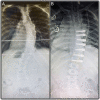Early-onset scoliosis: a narrative review
- PMID: 35924646
- PMCID: PMC9458941
- DOI: 10.1530/EOR-22-0040
Early-onset scoliosis: a narrative review
Abstract
Early-onset scoliosis (EOS) is defined as any spinal deformity that is present before 10 years old, regardless of etiology. Deformity must be evaluated based on the intercorrelation between the lungs, spine, and thorax. Curvatures of early-onset have increased risk of progression, cardiorespiratory problems, and increased morbidity and mortality. Progression of the deformity may produce thoracic insufficiency syndrome, where a distorted thorax is unable to support normal respiratory function or lung growth. Management and treatment of EOS should pursue a holistic approach in which the psychological impact and quality of life of the patient are also taken into consideration. Growth-friendly surgical techniques have not met the initial expectations of correcting scoliotic deformity, promoting thoracic growth, and improving pulmonary function.
Keywords: complications; early-onset scoliosis; growth-friendly surgery; outcomes; quality of life; thoracic insufficiency syndrome.
Figures




References
-
- Ponseti IV, Friedman B. Prognosis in idiopathic scoliosis. Journal of Bone and Joint Surgery: American volume 195032A381–395. - PubMed
-
- Dickson R.Early-onset idiopathic scoliosis. Pediatric Spine: Principles and PracticeS Weinstein (Ed), 421 -–429.. Raven Press:New York: 1994.
Publication types
LinkOut - more resources
Full Text Sources
Medical
Miscellaneous

